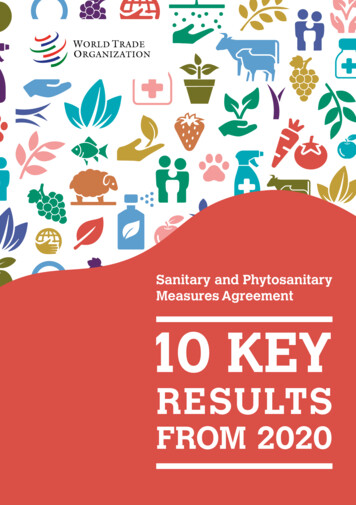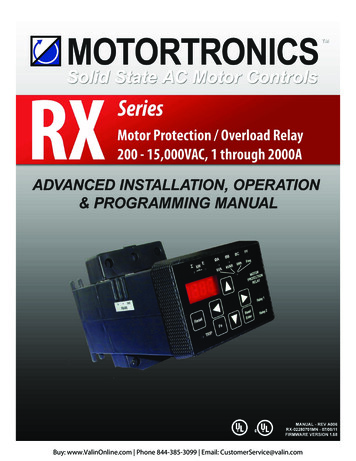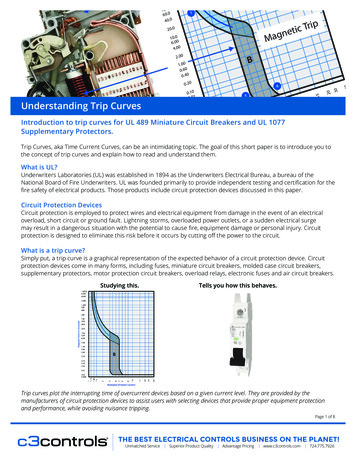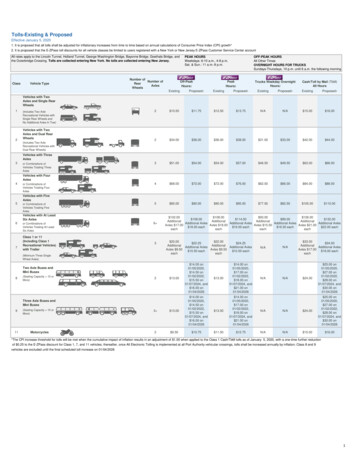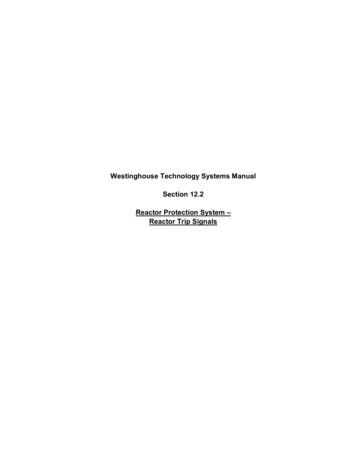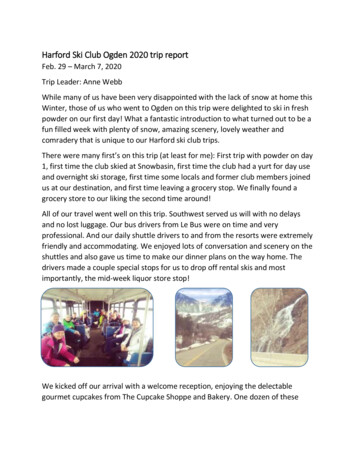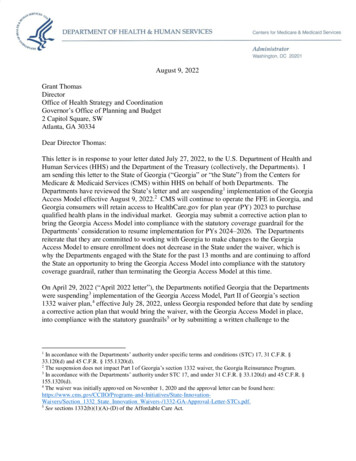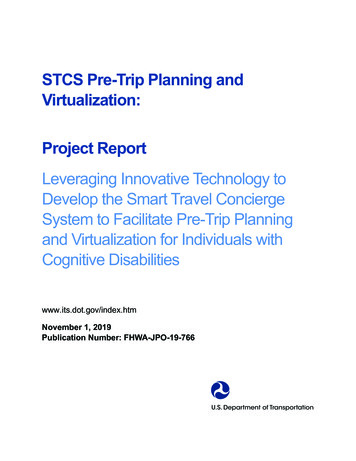
Transcription
STCS Pre-Trip Planning andVirtualization:Project ReportLeveraging Innovative Technology toDevelop the Smart Travel ConciergeSystem to Facilitate Pre-Trip Planningand Virtualization for Individuals withCognitive Disabilitieswww.its.dot.gov/index.htmNovember 1, 2019Publication Number: FHWA-JPO-19-766
Produced by AbleLink Smart Living Technologies, LLCU.S. Department of TransportationOffice of the Assistant Secretary for Research and TechnologyIntelligent Transportation SystemsJoint Program OfficeNoticeThis document is disseminated under the sponsorship of the Department ofTransportation in the interest of information exchange. The United StatesGovernment assumes no liability for its contents or use thereof.The U.S. Government is not endorsing any manufacturers, products, or servicescited herein and any trade name that may appear in the work has been includedonly because it is essential to the contents of the work.
Technical Report Documentation Page1. Report No.2. Government Accession No.3. Recipient’s Catalog No.FHWA-JPO-19-766(Delete and insert information here or leave blank)(Delete and insert information here or leave blank)4. Title and Subtitle5. Report DateSTCS Pre-Trip Planning and Virtualization: Project ReportNovember 31, 2019Leveraging Innovative Technology to Develop the Smart Travel ConciergeSystem to Facilitate Pre-Trip Planning and Virtualization for Individuals withCognitive Disabilities6. Performing Organization Code7. Author(s)8. Performing Organization Report No.Steven E. Stock(Delete and insert information here or leave blank)(Delete and insert information here or leave blank)Daniel K. Davies9. Performing Organization Name and Address10. Work Unit No. (TRAIS)AbleLink Smart Living Technologies, LLC(Delete and insert information here or leave blank)6745 Rangewood Dr. Suite 21011. Contract or Grant No.Colorado Springs, CO 80918DTFH6117C00013719-592-034712. Sponsoring Agency Name and Address13. Type of Report and Period CoveredFederal Highway Administration(Delete and insert information here or leave blank)PO Box 26886514. Sponsoring Agency CodeOklahoma City, OK 73126-8865(Delete and insert information here or leave blank)15. Supplementary NotesNone16. AbstractIndividuals with cognitive disabilities, such as intellectual and developmental disability, those on the autism spectrum,and people with traumatic brain injuries, can face significant obstacles in accessing America’s many transportationoptions. Many of these individuals do not own or use personal vehicles, and can be reliant on public transportation toaccess employment, education, health services, social/recreational activities, and other activities of daily living. Inmany cases these individuals are reliant on specialized paratransit services required by various federal laws.This project aimed at creating a series of cognitively accessible tools designed to support pre-trip assessment, training,planning and virtualization to promote greater access to fixed route transportation services for individuals who mayotherwise be reliant on paratransit. This resulted in the Smart Living Concierge System, comprised of four subsystemsdesigned to support self-assessment of current transportation skills, general training on those skills, personalized toolsto support timely and accurate completion of pre-trip preparation activities, and to virtually experience trips prior toactual engagement in travel.17. Keywords18. Distribution Statementtechnology, disability, transportation, assessment,readiness, independence(Delete and insert information here or leave blank)19. Security Classif. (of this report)20. Security Classif. (of this page)(Delete and insert information here or leave blank)(Delete and insert information here or leave blank)Form DOT F 1700.7 (8-72)21. No. of Pages22. Price62Reproduction of completed page authorized
AcknowledgementsAbleLink Smart Living Technologies would like to acknowledge the many individuals, agencies,universities and others who provided information, feedback, evaluation, and other support in pursuit ofthis project. We would specifically like to thank our field evaluation partners at Merakey, Black HillsWorks, ARCA, and Ability Beyond, and the various members of the Project Steering Committee. Finally,AbleLink is appreciative of the support and guidance provided by Noblis throughout the project.U.S. Department of TransportationOffice of the Assistant Secretary for Research and TechnologyIntelligent Transportation Systems Joint Program OfficeSTCS Pre-Trip Planning and Virtualization: Project Report i
Table of ContentsExecutive Summary . 1Chapter 1. Requirements Development . 7Overview .7System Requirements Development .7Chapter 2. Subsystem Descriptions . 10Subsystem Designs .10Content Development for Subsystems 1 and 2 .13Subsystem Development.13Transportation Readiness Assessment Subsystem .14Transportation Skills Training Library Subsystem .21Pre-Trip Execution Subsystem .29Trip Virtualization Subsystem .38Accessing the STCS Subsystems .43Chapter 3. Testing, Evaluation, and Field Implementation Activities. 46Finalize Plans and Procedures .46Overview of Field Testing .46Objectives .46Study 1: Evaluation of STCS Assessment Subsystem Approach .47Study 2: Evaluation of Pre-Trip Checklist and Schedule System Components .49Field Implementation Activities .52WayFinder Case Study Sample from Field Implementation Activities .59Summary.60Appendix A. References . 63U.S. Department of TransportationOffice of the Assistant Secretary for Research and TechnologyIntelligent Transportation Systems Joint Program OfficeSTCS Pre-Trip Planning and Virtualization: Project Report iii
Table of ContentsList of TablesTable 1. STLC Training Modules and Relationship with Assessment Modules . 11Table 2. Assessment and Training Evaluation Paired Samples Descriptive Statistics . 48Table 3. Assessment and Training Evaluation Paired Samples t-test . 48Table 4. Pre-trip Checklist and Schedule System Evaluation Paired Samples t-test . 50Table 5. Paired Data Set – Street Crossing Skills Survey . 55Table 6. Social Skills Survey Paired Samples t-test . 55Table 7.Street Crossing Skills Descriptive Statistics . 55Table 8. Paired Data Set – Social Skills Survey. 56Table 9. Social Skills Survey Paired Samples t-test . 56Table 10. Social Skills Survey Paired Samples Descriptive Statistics . 56List of FiguresFigure 1. STCS Functional Block Diagram . 3Figure 2. The Main Menu in the Transportation Skills Assessment System . 14Figure 3. The Information screen in the Social Skills Survey . 15Figure 4. Sample question in the Social Skills Survey without Next button showing before selection of ananswer . 16Figure 5. Sample question in the Social Skills Survey with Next button showing following selection of ananswer . 17Figure 6. Sample of Picture Question with enlarged answer set images . 18Figure 7. Sample of last question in an assessment with Done button showing . 19Figure 8. Assessment Report Summary Page with Suggested Tasks . 20Figure 9. Social Skills Transportation Readiness Report. 21Figure 10. The Main Menu of the Transportation Skills Training Library System . 22Figure 11. Start page of “Getting Help in the Community” Training Session . 23Figure 12. Example page from “Getting Help in the Community” Training Session . 24Figure 13. The opening screen, or Main Menu, of the STCS study prototype . 25Figure 14. The Start screen of the Set B module in the STCS evaluation prototype . 26Figure 15. Sample screen of the Training Task module in the STCS evaluation application . 27Figure 16. Tapping the Done button, which only appears at the end of each task module sequence,triggers the automated notification message as shown in Figure 17. . 28Figure 17. Sample of automated remote notification email indicating module completion . 29Figure 18. Sample of Pre-Trip Execution system’s schedule display . 30Figure 19. Sample of Pre-Trip Execution system’s schedule display . 31Figure 20. Activities List with new event for Starting WayFinder for Work Route to Target showing . 32Figure 21. Schedule system Advanced Settings display for automatically launching the Getting Ready forWork pre-trip checklist . 33Figure 22. Schedule system Alert screen that activates when a scheduled event is launched . 34Figure 23. Schedule system Settings display for personalizing the interface and operation . 35U.S. Department of TransportationOffice of the Assistant Secretary for Research and TechnologyIntelligent Transportation Systems Joint Program Officeiv STCS Pre-Trip Planning and Virtualization: Project Report
Table of ContentsFigure 24. Pre-Trip Checklist Interface . 37Figure 25. SMART Virtualization Creator – Main Menu with SMART Routes Downloaded from a SMARTRoute Library . 38Figure 26. SMART Virtualization Creator – Display showing a Virtualization Scenario being built for “Bus34 – UCCS to Goodwill” SMART Route . 39Figure 27. Simulated WayFinder app is used to launch Virtualization Scenario . 40Figure 28. Virtualization Scenario with Simulated Wayfinding App. 41Figure 29. Virtualization Scenario illustrating it is time to notify the driver to stop at the next bus stop withthe simulated Wayfinding app . 42Figure 30. Virtualization Scenario Video Shown in SMART Route Library . 43Figure 31. AbleLink’s ATTRI web portal site . 44Figure 32. Beginning of STCS section of ATTRI project web portal site. 45Figure 33. Study participant engaging in the Identifying Vehicles by Number ATTRI Assessment . 49Figure 34. Study participant engaging in pre-trip execution prototype systems . 52Figure 35. Survey Reports Home Page showing Merakey’s Completed Surveys . 53Figure 36. Bar charts show overall responses for each item in a survey . 54Figure 37. SMART Virtualization Creator App with SMART Routes Created by ARCA . 58Figure 38. Smart Columbus Website . 59U.S. Department of TransportationOffice of the Assistant Secretary for Research and TechnologyIntelligent Transportation Systems Joint Program OfficeSTCS Pre-Trip Planning and Virtualization: Project Report v
Executive SummaryThis report summarizes the activities, milestones, deliverables, and other accomplishments of a two-yeareffort under the Accessible Transportation Technology Research Initiative (ATTRI) conducted by AbleLinkSmart Living Technologies and titled Leveraging Innovative Technology to Develop the Smart TravelConcierge System to Facilitate Pre-Trip Planning and Virtualization for Individuals with CognitiveDisabilities.This project involved development and evaluation of the Smart Travel Concierge System (STCS), a suiteof technologies for assessment of transportation readiness, training on a range of general publictransportation skills, pre-trip planning and execution applications, and trip virtualization activitiesspecifically for individuals with cognitive disabilities and other users to support increased independence inuse of fixed route transportation and to reduce the need to use costlier paratransit services. Assessingtransportation skills, pre-trip planning and trip execution technologies are critical components necessaryfor facilitating successful use of public transportation systems. The STCS provides new technology forvirtualization experiences of routes and leverages existing technology to provide a comprehensive set oftransportation readiness assessment and self-directed learning materials, as well as trip executiontechnologies that address individualized pre-trip planning, preparation and logistics that are important forengaging in independent travel. Previous research has demonstrated that the technologies that wereleveraged to create the STCS (i.e., Visual Impact; the Accessible Testing, Learning and AssessmentSystem, Endeavor) have enabled individuals with cognitive disabilities to complete self-directedassessments and perform daily living activities more independently in a wide variety of contexts (Davies,et. al., 2017; Schwartz, et. al., 2013; Shogren et. al. 2013; Tanis, et. al., 2012; O’Hara, et. al., 2008;Wehmeyer, et. al. 2006). In addition, agencies serving individuals with cognitive disabilities can reducestaff support costs through use of these types of tools (White, Liberatos, O’Hara, Davies & Stock, 2013;Schwartz, et al., 2013; Davies, Stock & Wehmeyer, 2004). This project has allowed these technologies tobe extended into the transportation arena to enhance pre-trip assessment, planning and trip execution forpeople whose cognitive disabilities or other limitations have precluded more comprehensive use ofmainstream public transit.The initial work in this project involved development and concept validation of a STCS prototype system.This was followed by final completion of the system and conduct of field evaluation activities. The systemleverages previously developed technology and provides a powerful companion system to complementthe Special Media for Assisting Route Travel (SMART) wayfinding set of tools that were developed orenhanced in AbleLink’s complimentary ATTRI project, titled Leveraging Innovative Technology to Developthe SMART Wayfinding Standard to Facilitate Independent Use of Public Transit by Individuals withCognitive Disabilities. WayFinder is the first SMART (Special Media for Assisting Route Travel) readyapplication to support use of fixed route transportation systems. It has been previously validated throughresearch and ongoing usage by travelers with disabilities (Davies, Stock, Holloway and Wehmeyer, 2010;Stock, Davies, Wehmeyer and Lachapelle, 2011; Stock, Davies, Hoelzel and Mullen, 2013; Stock, Davies,Herold and Wehmeyer, 2019). It is important to note that the STCS subsystems that were developed inthis project can be used independently as stand-alone components to support pre-trip planning or inconcert with WayFinder and its associated components. In other words, previous experience has shownU.S. Department of TransportationOffice of the Assistant Secretary for Research and TechnologyIntelligent Transportation Systems Joint Program OfficeSTCS Pre-Trip Planning and Virtualization: Project Report 1
Executive Summarycustomer use cases where individuals with different travel support needs may engage individualsubsystems or combinations thereof of the set of ATTRI technology tools.It is well known that certain accommodations for individuals with disabilities can provide benefit formainstream populations as well. For example, curb cuts designed for people with physical disabilitiesalso benefit parents with strollers, and automatic door openers improve accessibility for people carryingpackages. In the same way, the cognitively accessible design strategies being employed by STCSprovide the potential to improve access for all people, including those who may be less comfortable withpublic transportation in general. Cognitively accessible design can simply make things easier foreveryone. The STCS is comprised of four subsystems, each of which contains cognitive design features.These subsystems have been designed such that they can be used individually or in combination witheach other depending on the unique needs of each use case. A brief description of each subsystem isprovided below, followed by examples of how they may be used individually or in combination to furtherexpand on how the subsystems may be implemented.Transportation Skills Assessment System--The first subsystem is a web-based assessment systemprovides a format for individuals with cognitive disabilities, older adults and other users who may be lessfamiliar with public transit to complete one or more self-assessments of public transit experience andskills. Results from completed assessments are immediately available via an on-line reporting library forviewing and to print reports. Results of individual assessments are also integrated to inform self-directedtransportation skills learning in the second subsystem, described subsequently.Transportation Skills Training Library—The second subsystem is a web-based general transportationtraining skills application that provides self-paced opportunities to address general transportation skillsdeficits, including those that may have been identified via the Transportation Skills Assessmentsubsystem. The content for this general skills training system was developed via research conductedduring the STCS project and can also be deployed for specific transit agencies to regionalize content asneeded. While these first two subsystems have a degree of integration with each other, users are alsoable to engage in self-assessment and general training processes independent of each other if requiredby individual use cases. The intent of these first two subsystems is to provide more general, high-leveltravel skills assessment and training, while the second two subsystems are designed to begin addressingmore individualized, route-specific supports.Pre-Trip Execution System—The third subsystem involves pre-trip planning, preparation, and tripexecution activities that are specific to individual users and their travel needs. The components of thismobile device-based subsystem include a cognitively accessible personal scheduling system to supportthe ‘when’ in keeping a traveler on time with pre-trip preparation activities, and an instructional system tosupport the ‘how’ in completing these pre-trip activities. This instructional system uses an approachsimilar to the general transportation skills training subsystem described above, but instructional content isauthored by individual users and/or trainers to provide personalized, route-specific supports and includean interactive pre-trip checklist format.Trip Virtualization System—Finally, the fourth subsystem has been designed to allow users toexperience a travel route virtually without having to leave home. Travel trainers or caregivers can capturevideo footage of a desired travel route from beginning to end, and then overlay the GPS-based promptsfrom a SMART-compliant route via a simulated on-screen WayFinder interface with the video to virtuallyexperience the route. The virtualization system has been designed for use on a full screen computerU.S. Department of TransportationOffice of the Assistant Secretary for Research and TechnologyIntelligent Transportation Systems Joint Program Office2 STCS Pre-Trip Planning and Virtualization: Project Report
Executive Summaryplatform to provide a rich, immersive and realistic virtual experience and to support synchronized video/mobile app simulation playback on the larger screen format available on desktop or notebook computers.Figure 1 provides a graphic illustration of the interaction between the STCS prototype subsystems.Source: AbleLink Smart Living Technologies, May 15, 2018Figure 1. STCS Functional Block DiagramUnderstanding the Subsystems of STCSThe first two subsystems—the Transportation Readiness Assessment System and the TransportationSkills Training Library—include a degree of integration such that they can each be used by themselves orin conjunction with each other. Responses to questions in the transportation readiness assessmentshave been mapped to specific skill training modules to provide a degree of automation in prompting usersto engage in training areas identified as deficits by the assessment process. Users are also able toU.S. Department of TransportationOffice of the Assistant Secretary for Research and TechnologyIntelligent Transportation Systems Joint Program OfficeSTCS Pre-Trip Planning and Virtualization: Project Report 3
Executive Summaryengage in the Transportation Skills Training Library independent of the assessment process in thattransportation training modules are also manually selectable to allow users to engage in additional oralternative training as desired. These first two subsystems are designed to address general travel skillsthat are not necessarily specific to a particular route. The second two subsystems then move the focus tospecific individualized traveler needs and route training. The pre-trip execution subsystem provides thecapability for users to receive personalized time-based prompts to perform key pre-trip preparationactivities which may include sequential or non-sequential (e.g., checklist) tasks. Finally, the virtualizationsubsystem provides the capability to review route-specific virtualization scenarios to supportfamiliarization of key travel elements prior to engagement in route-specific public transportation activities.Internet connectivity is required when downloading virtualization scenarios from the SMART RouteLibrary, but once a virtualization scenario has been downloaded, internet connectivity is not required forplayback of the scenarios.Examples of Using the Subsystems Individually or in CombinationExample #1—Some agencies or individuals may have already invested resources in an alternative orhome-grown public transportation training program. In these cases, it is possible that only theTransportation Readiness Assessment System is used to help identify which parts of the training programmay be needed by an individual, or to measure the effectiveness of engagement in a local trainingprogram.Example #2—Other agencies that may have a fairly comprehensive public transit training program thatincludes assessment, training, and travel trainer supports may desire to integrate the virtualizationsubsystem to fill a gap in their program. Several members of the project Steering Committee haveindicated that they already gather trip video footage that could be used in a much richer, more immersiveenvironment such in the Trip Virtualization subsystem.Example #3—A family may wish to support a member with intellectual disability to learn a bus route toanother family member’s home; the family may use the Assessment subsystem to help determinepotential safety issues, then the Transportation Skills Training Library to provide training on identifiedareas, and finally the Pre-Trip Checklist to support successful travel before using the WayFinder app tohelp guide the rider to his or her destination.Example #4—A public transit service may adopt all aspects of the STCS that could be administered byan existing team of travel managers and trainers who have themselves been trained on use of the STCS.In this case the transit service may provide additional content to the Transportation Skills Training Library,develop customizable Pre-Trip Checklist templates and build/store downloadable travel routes and/orvirtualization scenarios for use with the ATTRI projects’ systems.Expected Impact of the ResearchThe impact of this research and development project is underscored by the significant cost differencesbetween provision of paratransit versus fixed route transportation services provided by municipalitiesacross the country. Paratransit services cost from seven to 10 times higher than fixed route services(CUTR, 2008; Kloehn, 2016). Given this large discrepancy in cost per trip between paratransit and fixedroute services, significant cost savings could be realized by moving a segment of the paratransit ridershipto mainstream fixed route services. In its 2014 guide on strategies to promote use of fixed route transit bypeople with disabilities, the Transit Cooperative Research Program (TCRP) estimates that even at a 25%U.S. Department of TransportationOffice of the Assistant Secretary for Research and TechnologyIntelligent Transportation Systems Joint Program Office4 STCS Pre-Trip Planning and Virtualization: Project Report
Executive Summaryconversion rate, savings to municipal transit systems could exceed 9 million annually for the country’slargest transit providers (TCRP, 2014). The pre-trip planning and virtualization technologies developed inthis project have been designed to meet a significant need that exists even before the trip begins. Whenused to teach individuals to use the fixed route system independently, these supports can be expected toresult in large-cost savings for transit authorities and consumers with cognitive disabilities and other usersas a result of helping to effectively transition individuals from paratransit to fixed route transportationservices.U.S. Department of TransportationOffice of the Assistant Secretary for Research and TechnologyIntelligent Transportation Systems Joint Program OfficeSTCS Pre-Trip Planning and Virtualization: Project Report 5
Chapter 1. Requirements DevelopmentOverviewThe initial task in this project involved the development of the functional, techni
also researched the status of smart transportation technology development, virtualization technology approaches, and connected mobile and wearable devices that can support pre-trip planning and trip execution. A significant portion of this effort was in reviewing existing tools and strategies for assessing
